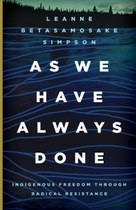Yes! Magazine: Resisting the Power Structures That Keep Colonialism Alive
 I am interested in freedom, not survival, and as kwe, I understand my freedom is dependent upon the destruction of settler colonialism.
I am interested in freedom, not survival, and as kwe, I understand my freedom is dependent upon the destruction of settler colonialism.
I understand settler colonialism’s present structure as one that is formed and maintained by a series of processes for the purposes of dispossessing, that create scaffolding within which my relationship to the state is contained. I certainly do not experience it as a historical incident that has unfortunate consequences in the present. I experience it as a gendered structure and a series of complex and overlapping processes that work together as a cohort to maintain the structure. The structure is one of perpetual disappearance of Indigenous bodies for perpetual territorial acquisition, to use Patrick Wolfe’s phrase. I think the insight that settler colonialism is formed and maintained by a series of processes is important because it recognizes that the state sets up different controlled points of interaction through its practices—consultations, negotiations, high-level meetings, inquiries, royal commissions, police, and law, for instance, that slightly shift, at least temporarily and on microscales, our experience of settler colonialism as a structure. The state uses its asymmetric power to ensure it always controls the processes as a mechanism for managing Indigenous sorrow, anger, and resistance, and this ensures the outcome remains consistent with its goal of maintaining dispossession.
By: Leanne Betasamosake Simpson
Story Date: 2018-07-17T05:00:00+00:00



